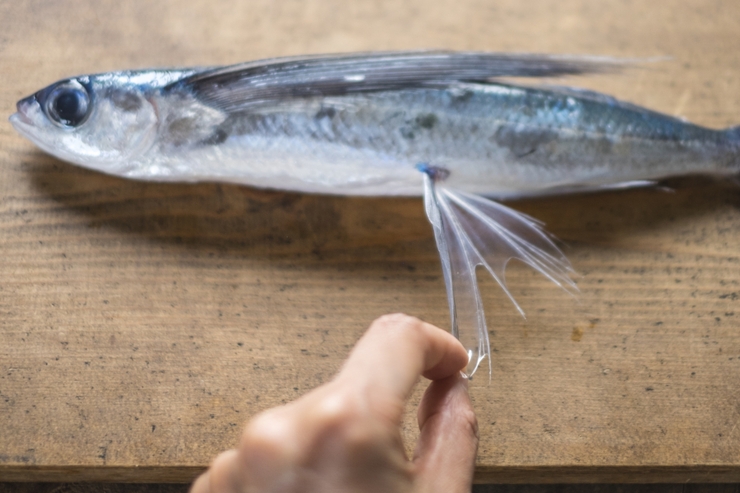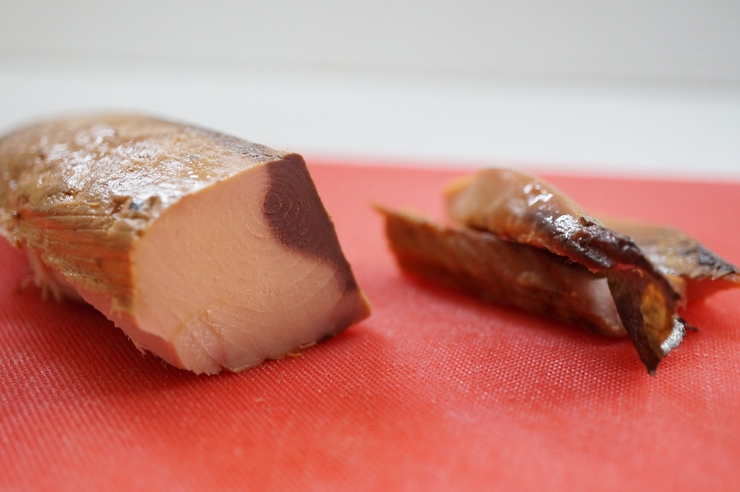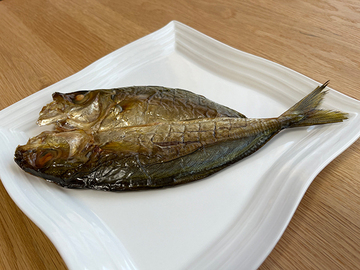Smoked foods


History and culture
Smoked products are made by smoking fishery products or other foodstuffs to produce a characteristic flavor and improve the shelf life, or the wisdom of preserving foods longer. By pretreating ingredients and smoking them with a smoking material, smoke is allowed to permeate into the ingredients and add a characteristic flavor and color to them. In the process of smoking, water is removed from ingredients, and volatile components in smoke adhere to their surface, which helps to prevent them from being rotten or oxidized.
There is a theory that the process of making smoked products was introduced to Japan in the Edo era, when the culture of eating smoked fishery products and other smoked foodstuffs was rooted in Japan, but there are other theories about the origin of smoked products and their history is unclear. Smoked fishes made by removing the guts, blood, and gills from fishes, salting them, seasoning them with sake, sugar, soy sauce, etc., and drying them are common in Japan.
Livestock products may be smoked, but such smoked livestock products are introduced in "15 Processed livestock products (meats, eggs, dairy products, honey, etc.)."
Characteristics and types
The characteristics of typical smoked products are introduced below:

[Smoked salmon]
It is said that "Rakan" made by the Ainu by hanging and drying salmon above a fireplace is the original form of smoked salmon. In and after the Meiji era, the fisheries experiment stations in Hokkaido have introduced manufacturing technologies from the U.S. and Europe and strived to disseminate smoked salmon through producing smoked salmon experimentally, popularizing it and providing guidance on manufacturing it. Many smoked salmon products are made by cold-smoking. Well-dried smoked salmon products made of salmon cut into three fillets are common. Different kinds of salmon such as chum salmon, cherry salmon, and trout are used to produce smoked salmon.

[Smoked flying fish]
Smoked flying fish is produced mainly in Hachijo-jima Island of Tokyo Metropolis, Tanega-shima Island of Kagoshima Prefecture, and the Yaku-shima Island region. There is a theory that smoked flying fish originated from dried-salted flying fish in Nii-jima Island of Tokyo Metropolis. It is said that 30 kinds of flying fish live in Japan. The smoke-drying period for producing smoked flying fish is relatively short, and its shelf life is not so long. Consequently, smoked flying fish is commonly sold in a vacuum package. It has a soft texture and a characteristic flavor.

[Namaribushi]
Namaribushi is made by boiling bonito fillets and removing bones or roasting them by using gas or electric heat. In the smoking process for making honbushi, a kind of dried bonito, bonito fillets are heated once first. The fillets after the first heating are called "namaribushi" or "namabushi." It is believed that the name "namaribushi" originates from the Japanese expression meaning using raw fillets. Today, products packed in a deaerated package and sterilized by heating are distributed on the market.
Production methods
Methods for producing smoked products are roughly divided into three types: cold-smoking, hot-smoking, and seasoning and hot-smoking.
[Cold-smoking]
Cold-smoking is a production method intended to preserve foodstuffs longer. Foodstuffs are pretreated, salted, desalted, air-dried, and smoke-dried (let sit). The smoke-drying temperature is between 15 and 30°C, and the smoke-drying period is as long as 1 to 3 weeks. Smoked products made by this method contain a small amount of water and have a long shelf life, but tend to be hard in texture.
[Hot-smoking]
Hot-smoking is a production method intended to season foodstuffs. The processes from pretreatment to smoke-drying are similar to cold smoking, but the smoke-drying temperature is as high as 30 to 80°C, and the smoking period is as short as 1 to 6 hours. Smoked products made by this method contain a large amount of water and have a short shelf life, but have a flavor that the original foodstuffs do not have, and are soft in texture.
[Seasoning and hot-smoking]
The production method is the same as hot smoking, but foodstuffs are seasoned before the smoke-drying process. Therefore, the Umami of the ingredients and the flavor produced by smoke-drying are matured, making the foodstuff tastier.
Relationship with regions
According to the statistical survey on processed marine products conducted in 2021 (by the Ministry of Agriculture, Forestry and Fisheries), the production of smoked marine products in Japan is approx. 7,000 tons, which account for approx. 0.4% of the total processed marine product production of approx. 1.43 million tons. Various local specialties that are made by using salmon, trout, herring, squid, scallop, oyster, eel, octopus, blowfish, yellowtail, fly fish, or other fishery products as ingredients and are based on the different taste preferences of different regions have been handed down.
Contribution to sustainability and SDGs
Smoked products contribute to sustainability and SDGs in that "branches generated by pruning fruit trees or scrap wood is reused as smoking materials" and "fishes that are not sold or distributed as marine products are used as ingredients" (Goal 14: Life Below Water, Goal 15: Life On Land).
Reference
"Nihon no Dentoshoku Jiten" (Encyclopedia of Japanese Traditional Foods), authored by Hiroyasu Oka, Masakatsu Sakamoto, Seiko Tamotsu, and Akira Nomura and edited by Nihon Dento Shokuhin Kenkyukai (study group), Asakura Publishing Co., Ltd., pp. 461-468

